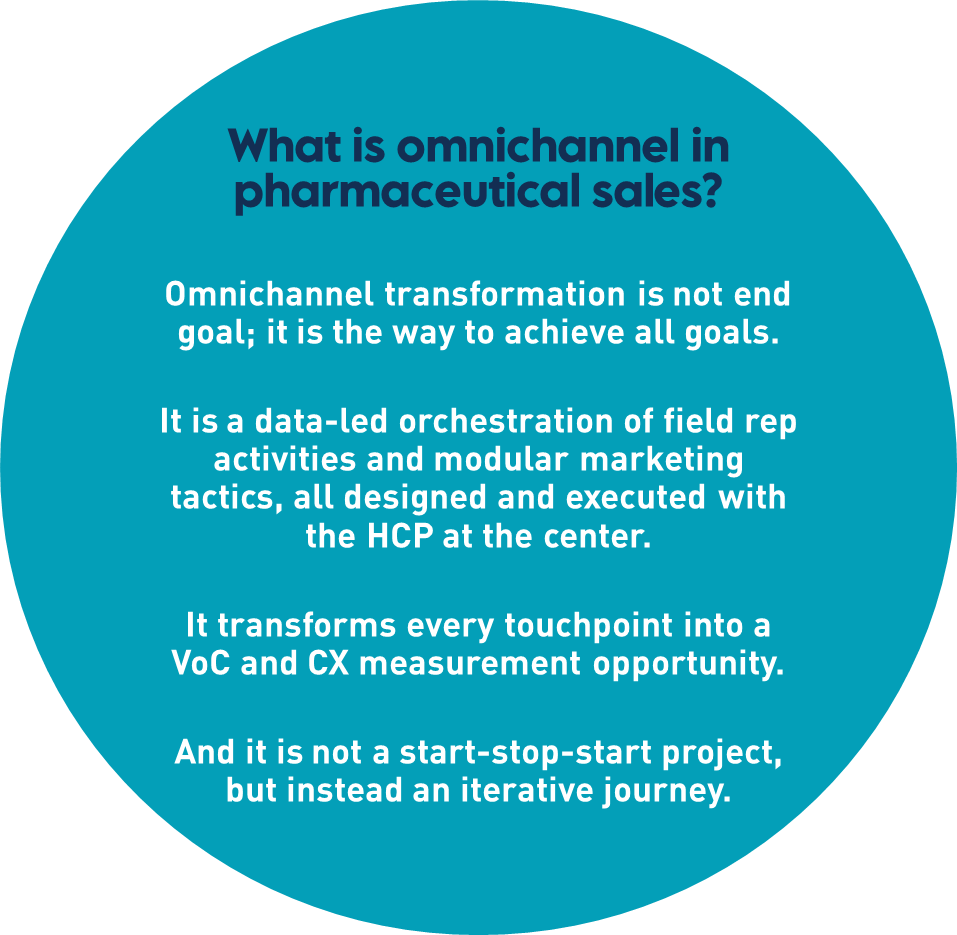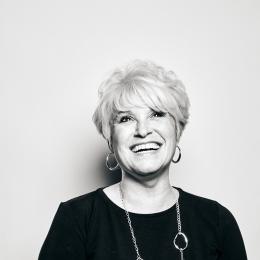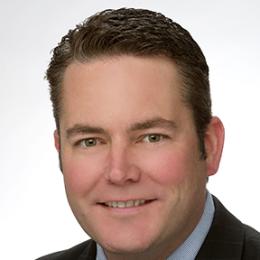The days of drop-in, in-person engagement on the fly are all but over for pharmaceutical sales and marketing organizations. The healthcare providers (HCPs) that even allow field representative access (less than half) no longer have the time—or the desire—to engage in the ways they used to. Pharmaceutical companies must redefine the field rep role and transform operations to put the HCP at the core. Data—the kind that defines HCP needs and preferences, and powers field reps to show up when, where, and how they’re needed most—is the key. Collecting, integrating, and activating a flywheel of value-add data, on-demand and through the right channel, must become mission critical for the field force of the future.
Your healthcare provider’s alarm goes off at 5:00 a.m. She has to get in a workout, break a sweat, before her first patient at 7:30 a.m. Exercise—which she’s prescribing to a growing number of patients reporting depression and heart-pounding anxiety—might be the only thing preventing her own complete burnout.
She’ll see around 20 patients today in her primary care practice. They’ve each waited an average of 26 days to see her, so the pressure to deliver, solve, and cure is high. If she follows the national recommended guidelines for preventive, chronic disease, and acute care, she’d need 26.7 hours to serve that many patients. She has just 8 to 10, so each patient gets roughly 18 minutes of her time.
Even within this untenable schedule, she still prefers a face-to-face meeting with her pharmaceutical field rep. But to make it worth her time—which is occupied with more than three hours of electronic health records and in-box management between patient visits—that in-person engagement must deliver custom, timely, and relevant information above and beyond a sales pitch. And she expects engagement across multiple channels—from social media and chats to webinars and email—that is real-time, data-rich, and custom-fit.
It’s an expectation that is hard met with traditional ways of working. The field rep of yore fought traffic in the company car to work a self-established beat, all under systems and schedules that allowed for frequent, casual drop-ins.
Then the pandemic expedited the development of nascent trends (HCP access has been steadily declining since 2008) into a new normal. And this new normal, marked by over-extended HCPs and more virtual engagement, created an opportunity for pharmaceutical sales and marketing organizations: How do you re-think the field rep role, re-center your operations around the customer, and capitalize on virtual engagements to truly partner with HCPs to deliver better patient outcomes?
Defining the field rep of the future: A partner in data-driven outcomes
The field rep of the future won’t be driven by self-designed routes and pre-scheduled, quarterly activities. Instead, they’ll be fueled by data. Their activities will be triggered by AI-powered insights and executed through client-preferred channels. They will meet the HCP when and where they’re needed, and they will be empowered—through tools, incentives, and organizational structures—to fuel their organization with insights from the frontline; insights that will power a flywheel of value-add data to inform HCP engagement enterprise-wide. They’ll be more than sales reps: They will be data-driven generators of better patient outcomes and enterprise-wide strategic momentum.
While many industry leaders are working toward this vision, it is still largely aspirational and piecemeal in practice today. Based on our aggregated expertise and experience in the field we are helping those industry leaders incrementally and strategically bring this vision to life, starting with a definition of the attributions and functions the field rep of the future will employ.
The rep of the future … identifies new and improved ways to serve customers, including with data-driven insights that deliver real-time results.
- They trust and embrace data and analytics (D&A), understanding that data drives personalized and efficient customer experiences.
- They act on insights provided to them through AI, which allows them to spend more valuable time with patients.
- They respond to the highest-opportunity engagements in real-time, acting on triggered prompts regarding customer needs, both immediate and developing.
The rep of the future … utilizes all available channels to connect most effectively with HCPs, based on their unique preferences.
- They customize and deliver personalized customer engagements through multiple channels.
- They partner with matrix teams to co-create an integrated multi-channel engagement strategy.
- They connect with marketing to understand and support customer engagement tactics across all channels.
The rep of the future … recognizes that what made them successful in the past isn’t what will make them successful in the future.
- They move from a compliance-based reporting format—“here’s what I said to the HCP”—to capturing the critical voice of the customer (VoC) insights. Those insights—everything from why an HCP isn’t prescribing your product to the time of day they typically reach out to the call center—can be used to inform other channels, future engagement, and even product development.
The rep of the future … is just as interested in what they learn from HCP customers as what HCPs learn from them.
- They inform marketing of customer feedback to marketing materials presented during face-to-face and virtual engagements.
The new HCP experience
How does this new engagement model impact the HCP experience? She is still getting up too early, and her patient load is still untenable, but her relationships with her field force partners are intuitive and valuable.
Moments after a late-night search of a competitor’s drug alternative, a push notification spotlighting the features and benefits of your company’s option arrives in her inbox. The next morning, when a question comes up while charting, she turns to the on-demand chat option featured in the email for real-time answers.
Acting on the prompts triggered by her chat session, her field rep reaches out to schedule a visit. He knows she asked about safety and efficacy of action in the chat and comes to the visit armed with clinical data specific to that inquiry. He’s also armed with empathy: He knows her original Google search took place well after clinic hours.
From the HCP’s perspective, each touchpoint is seamless, efficient, personalized, and authentic. It’s on-demand data, service, and care when she needs it most.
Data-driven outcomes—brought to you by omnichannel
It’s not enough to simply redefine the field rep role. True data-driven impact is only realized as part of an omnichannel transformation, one in which critical sales and marketing functions are aligned, modular, and force multiplying. It’s a transformation that requires:

- Organizational alignment: Enterprise-wide consensus on the what, why, and how, with agreement on ways of working, roles, responsibilities, and performance measurement. This alignment must be centered on a unified goal and supported by an adequate budget.
- The prioritization of actions-to-value: Based on your maturity in core omnichannel capabilities, prioritize the activities that will strengthen the highest value, greatest impact omnichannel muscles. For example, if your agile ways of working are weak, focus on accelerating content approvals to enable faster, data-driven decision-making. If you’re struggling with capturing and actioning VoC insights, consider taking a deep dive into your closed-loop feedback systems and tactics, and deploying simple test-and-learn initiatives to inform a new future-forward strategy.
- Field force change management: Reinforce the “What’s in It for Me” (WIFM) with a focus on how an omnichannel approach makes face-to-face engagements more powerful. Without cross-functional buy-in across the enterprise organizations will struggle to establish the compounding flywheel of data collection, integration, and activation needed to fuel omnichannel success.
Start here: Establish your baseline to prioritize what’s next
While 98 percent of pharmaceutical executives agree that an omnichannel approach is important for their organization, just 11 percent report full, enterprise-wide omnichannel adoption. That leaves the vast majority of pharmaceutical organizations somewhere between strategy development and struggling to put scalable solutions in place.
A baseline assessment of organizational strengths—including D&A, culture, customer insights and VoC, agility, content delivery, and cross-functional collaboration—is critical to sustained and iterative omnichannel development, no matter where you are in your omnichannel journey. From there, the projects offering the greatest opportunities for enterprise-wide alignment and test-and-learn insights can be prioritized.
It’s a transformation journey that is never really complete. As the healthcare field continues to transform, so too must pharmaceutical sales and marketing organizations. And the strategies that drive those omnichannel transformations can’t just aim to keep up with HCP preferences and needs. Instead, they must be centered around the HCP in ways that don’t maintain in the new normal, but define the HCP and field rep relationship of the future.



